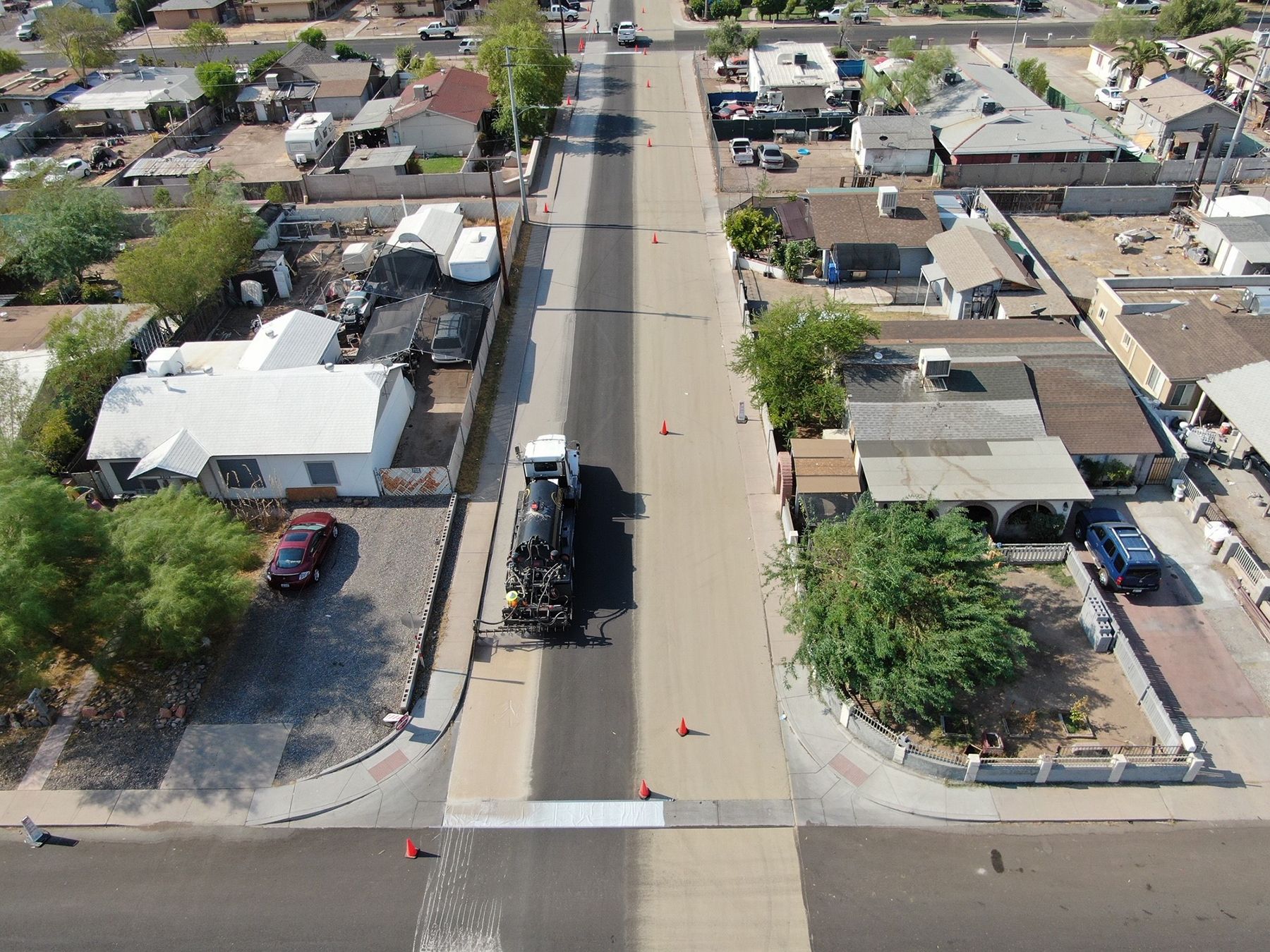By Brian Fortner
Human-made hardscapes — such as roadways, parking lots, and buildings — retain more heat during the day than natural landscapes. Because of this, their surrounding nightly temperatures can remain as much as 10 degrees Fahrenheit higher as the structures release that heat into the cooler night air. To combat this phenomenon — commonly referred to as the urban heat island effect — the cities of Los Angeles and Phoenix are coating asphalt roadways with reflective sealants to reduce their ability to absorb heat during the day, thus lessening the amount of heat released at night.
Asphalt can be a foot thick and absorb up to 90% of the sun’s energy that shines on it, creating a heat sink, but a light-colored coating only 100 microns thick can reflect as much as 40% of that energy so that it isn’t absorbed in the first place, according to Greg Spotts, the chief sustainability officer for Los Angeles’ Bureau of Street Services.
“All of our hardscape, our transportation infrastructure, is radiating heat into our neighborhoods even at 4 in the morning,” Spotts says. “In the summer, it's detectable from space.” Thermal imaging taken from satellites confirms this phenomenon. This issue is one that will get worse with the current trends in climate change. According to research out of UCLA, the average annual number of days that will exceed 95 degrees in downtown Los Angeles is expected to triple in the next 20 years, Spotts says.
“If you say the words ‘climate change,’ people talk to you about politics,” Spotts says. “But if you ask Angelenos of all economic stripes across the whole city — all different kinds of people — ‘What are you experiencing in your own neighborhood?’ every single person says, ‘My neighborhood is getting hotter.’”![]()
LA leads the way
Los Angeles was one of the first municipalities in the country to test these so-called cool pavements, and it recently rolled out its Next Phase Urban Cooling program, which will coat 200 blocks of neighborhood streets with sealant to create cool pavements and plant up to 2,000 trees across eight underserved neighborhoods that have high heat exposure and low tree canopy, Spotts says.
“We put hardscape everywhere, and even here in California or Arizona, we didn't really take into effect that we were designing our cities to be ovens,” Spotts says. Today the city is trying to create cooler neighborhood microclimates by planting trees and using cool pavements.
The Bureau of Street Services has done extensive testing with different sealants, colors, and application methods and continues to improve the process. Cool pavement pilot projects, which began in 2015 with one small parking lot application and today include one city block in each of the city’s 15 council districts, depicted a 10-degree cooling difference between areas with standard asphalt sealants and those that have streets sealed with coatings designed to create cool pavements.
Phoenix goes big
The success of pilot projects in Los Angeles led Phoenix officials to seal more than 36 mi of residential streets to create cool pavements last year. The city recently released a promising report on its pilot projects, with data and research compiled by Arizona State University’s Urban Climate Research Center.

The research team embedded temperature sensors in the asphalt and compiled temperature data taken at two heights for each location: on the street’s surface and in the ambient air 6 ft above the surface. The temperature of asphalt that had been treated with a reflective coating was as much as 5 degrees lower than untreated asphalt, according to the ASU findings. This reduction in thermal stress of the asphalt is expected to enhance the longevity of the roadway.
“Like sunscreen, cool pavement protects the roadway surface and insulates the asphalt,” says Ryan Stevens, P.E., a civil engineer for the city and one of its lead pavement management group engineers on the project.
Phoenix tested two cool pavement application methods, squeegee and spray. The city elected to use the spray method going forward because it could be applied faster and for lower labor costs. The cost of the cool pavement sealant itself is about $0.60 more per sq yd compared with typical asphalt sealants, says Rubben Lolly, P.E., the special projects administrator for Phoenix’s pavement management group. Typical asphalt sealants cost about $4.40 per sq yd, while the cool pavement reflective sealants cost about $5 per sq yd, according to Lolly.
Researchers in Phoenix are trying to determine the longevity of the cool pavement treatment coating. Early data suggest a decrease in reflectivity from a high of 40% to as little as 20% if the streets become coated with dirt and debris. In comparison, the reflectivity of regular asphalt is about 12%.
Phoenix has more than 5,000 mi of city streets over a 520 sq mi area. Because paved surfaces account for 30% to 40% of urbanized areas, a lot of surfaces would need to be covered with cool pavement to significantly reduce the heat island effect for the entire city. However, even with a 1-degree reduction in average temperature in the city, residents would save $15 million per year in avoided air conditioning costs alone, according to David Sailor, the director of the Urban Climate Research Center.
Sailor adds that only 40% of the energy content of the sun’s rays is in the visible spectrum, so cool pavements do not have to be glaringly white to reflect heat. Phoenix is working with its sealant manufacturer on different colors of cool pavement to appease public concerns over glare and maintain reflectivity. The pavement is currently a light gray with a matte finish to reduce glare.
Los Angeles and Phoenix are applying the reflective sealant on neighborhood roadways, as these see less traffic than roads in commercial areas and the cooling effect will be more readily felt by homeowners.
Cool pavements gain traction
The success of programs in Los Angeles and Phoenix has led other jurisdictions to begin addressing rising temperatures and ways to mitigate the urban heat island effect. The nonprofit Global Cool Cities Alliance established the Cool Roadways Partnership last year so that members could compare cool pavement information as sealant mixtures and colors are tested and best options are selected by individual jurisdictions. The Alliance currently consists of 28 jurisdictions in the United States, with 13 of the jurisdictions planning or conducting cool pavement pilot projects, according to Maria Koetter, executive director of the Alliance.
The benefits of cool pavements are not limited to warm climates. Every city can benefit from urban cooling, Koetter says. Cities like Cambridge, Massachusetts; Cincinnati; and Philadelphia are all interested in cool pavements and are members of the Alliance.
“Extreme heat, particularly in more vulnerable populations, is very pronounced in all cities, regardless of where you are,” Koetter says. In addition, asphalt preservation with cool pavements is being tested as far north as Alaska, according to Koetter. The extreme freeze-thaw cycles often wreak havoc on roadways in the state, and cool pavement could help keep permafrost from melting beneath roadways.
The benefits of cool pavements also are being recognized at the federal level. The recently passed massive infrastructure package includes a healthy streets section that would provide up to $500 million in grants over five years for cool pavements and other urban cooling methods like tree planting.



